Method to Measure Tone of Axial and Proximal Muscle
Özet
We have developed a device (Twister) to study the regulation of tonic muscle activity during active postural maintenance. Twister measures torsional resistance and muscular responses in standing subjects during twisting of the body axis. The device can be flexibly configured to study various aspects of tonic control across the neck, trunk, and/or hips.
Abstract
The control of tonic muscular activity remains poorly understood. While abnormal tone is commonly assessed clinically by measuring the passive resistance of relaxed limbs1, no systems are available to study tonic muscle control in a natural, active state of antigravity support. We have developed a device (Twister) to study tonic regulation of axial and proximal muscles during active postural maintenance (i.e. postural tone). Twister rotates axial body regions relative to each other about the vertical axis during stance, so as to twist the neck, trunk or hip regions. This twisting imposes length changes on axial muscles without changing the body’s relationship to gravity. Because Twister does not provide postural support, tone must be regulated to counteract gravitational torques. We quantify this tonic regulation by the restive torque to twisting, which reflects the state of all muscles undergoing length changes, as well as by electromyography of relevant muscles. Because tone is characterized by long-lasting low-level muscle activity, tonic control is studied with slow movements that produce “tonic” changes in muscle length, without evoking fast “phasic” responses. Twister can be reconfigured to study various aspects of muscle tone, such as co-contraction, tonic modulation to postural changes, tonic interactions across body segments, as well as perceptual thresholds to slow axial rotation. Twister can also be used to provide a quantitative measurement of the effects of disease on axial and proximal postural tone and assess the efficacy of intervention.
Protocol
1. Introduction
Twister is a servo-controlled device for quantifying postural tone in axial and proximal body regions during active, upright stance. The original device was constructed at Oregon Health & Science University and a similar device is under construction for the University of Southampton, UK. In this report, we describe the function and rationale for Twister and its various uses. We then provide a detailed description to facilitate its reproduction and show how it can be used to investigate the control of postural tone.
2. Overview
Twister consists of a rigid steel frame, rotating platform, torque sensor, counterbalanced suspension system, upper and lower fixations, and body attachments (Fig 1), as well as a servo control system for regulating platform rotation. Twister quantifies postural tone in standing subjects by rotating lower body segments about the vertical axis relative to upper segments. This twists the region in between, changing the length of muscles within. Upper and lower fixations can be attached to impart twisting to the neck, trunk or hip regions (Fig 2). Because Twister does not provide postural support, tonic activity of skeletal muscle is necessary to counteract gravitational torques. This tonic regulation is studied by the torsional resistance to twisting as well as electromyography from relevant muscles. Resistance to twisting is assessed by a torque sensor within the upper fixation and reflects the state of all muscles undergoing length changes. Twister uses several different platform rotation profiles to study tonic control, including a triangle profile, step profile, and triangle profile of increasing magnitude (Fig 3). These rotate the platform at a constant slow velocity, which minimizes inertial effects on the subject and measurement.
We use a twisting perturbation about the vertical axis because it: 1) changes the length of axial and proximal muscles, as these structures are oriented obliquely and have broad anatomic origins and insertions; 2) does not alter the relationship of the whole body and its parts to gravity; 3) rotates the body around an axis of minimal moment of inertia2; 4) corresponds to a neutral zone3,4, so that resistance from small displacements from the forward facing position reflects muscular rather than osteo-ligamentous forces; and 5) naturally occurs in everyday activities3,5.
Twister is a flexible device that can be used to address various aspects of tonic control. These include: 1) stiffness related to tonic activity6-8; 2) tonic responses to muscular length changes6,8. 3) the effect of twisting on remote body regions; 4) tonic effects from kinesthetic information9; 5) the effects of disease on postural tone7,10; and 6) perceptual thresholds to slow rotation11.
3. Detailed description of device
We detail the components of Twister below.
- Rotating platform
Subjects stand on a platform that rotates ±20°on a bearing about the vertical axis (Figs 1, 4A). An electric motor powers this rotation at a drive ratio that achieves platform speeds between 0.5°/s and 5°/s and high torque. Twister rotates the lower body in space, rather than the upper body to eliminate vestibular signals that could disrupt quiet stance. - A belt and pulley system is used for drive reduction, which dampens vibration and eliminates lash that can interfere with torque measurement. Vibration is minimized because it can cue the subject about platform motion.
- For safety, hard stops are used to limit maximal platform displacement.
- An optical encoder (Hewlett-Packard HEDS-5540) fixed to the platform shaft reports rotational displacement for both servo-control and data-analysis.
- Frame
A rigid, steel frame (1.5m x 1.5m x 3m) with diagonal cross bracing creates high torsional stiffness between the platform assembly and torque sensor, necessary for accurate torque measurement.
- Upper fixation and suspension system
The upper fixation and lightweight, counterbalanced suspension system connect the upper margin of the twisted region to the frame (Fig 4B). A torque sensor (Futek TFF220, Irvine, CA) positioned within the upper fixation measures a subject’s resistance to rotation. - The suspension system consists of four rectangular aluminum plates that are alternately hinged along the anterior-posterior and mediolateral axes. This creates a high stiffness for rotation about the vertical axis (590 Nm/°), in order to accurately measure torque, without restricting movement in other dimensions. In particular, the low stiffness for translation in x, y, and z directions (0.25 N/cm) ensures subjects maintain postural stability themselves and prevents the upper fixation from providing a spatial reference. This also allows each individual to maintain their own, unique vertical posture without affecting postural motion in the horizontal plane.
- Springs act to counteract the weight of the suspension system.
- A vertical bearing assembly (Fig 1, 4B) is used to adjust the upper fixation to subject height.
- Lower fixation
A lower fixation connects the lower margin of the twisted region to the rotating platform. Body segments below the lower fixation rotate with the platform. - The lower fixation consists of a lightweight telescoping bar that is connected to the rotating platform. A hinge connects the telescoping bar to the platform to allow anterior-posterior postural sway.
- Body Attachments
Three attachments are used with Twister: a lightweight helmet, a shoulder harness and a pelvis orthotic, which can each be securely fixed to the body (Fig 2). - To twist the neck, attach the helmet above and the shoulders below.
- To twist the trunk attach the shoulders above and the pelvis below
- To twist the hips attach the pelvis above. In this case, twisting is localized to internal and external hip rotation as the feet, shank and thigh rotate with the platform.
- External fixation
A third, external fixation can be used to twist one body region while measuring torque produced by another. Because the latter segment is stationary, the measured torque is not resistive but originates from muscular forces within the segment, potentially induced from remote twisting. - The external fixation consists of a lightweight telescoping bar that prevents the connected segment from rotating about the vertical axis. A hinge joint between the bar and frame allows anterior-posterior postural sway.
- Fig 4C shows the configuration for measuring neck torque during trunk twisting. Alternatively, neck torque in response to hip twisting can be assessed by connecting the pelvis to the external fixation.
- A standard forceplate can be placed between the subjects feet and rotating platform, to simultaneously measure resistive torque in the twisted segment. This forceplate can also be used to quantify postural sway during twisting.
- Servo-control of platform rotation
A custom built real-time servo-system controls platform rotation. This hardware PID controller outputs a motor drive signal based on a platform position signal from the optical encoder and the desired rotation (see Fig 7). A custom PC program interfaces with the hardware controller to specify the desired temporal profile of platform rotation and initiate a trial. - The controller generates three profiles for platform rotation. Select the triangle profile to alternate between constant-speed clockwise and counter-clockwise rotation (Fig. 3, trace 1). Use the step profile to achieve discontinuous rotation (Fig. 3, trace 2). Rotation can also be driven with a triangle profile that increases in amplitude across cycles (Fig. 3, trace 3).
- For all profiles, rotation is smoothed to limit acceleration to 12 °/s2 during movement initiation and directional changes.
4. Experimental protocol
A typical experimental is run as follows:
- Place body attachments (i.e. helmet, shoulder harness or pelvis orthotic) on the desired segments, ensuring they are snug and there is no torsional play.
- Adjust the height of the linear bearing so that the upper fixation is at the same height as the corresponding body attachment.
- Adjust the lower fixation using the telescoping bar to correspond to the height of the lower body attachment.
- Instruct the subject to stand on the rotating platform, facing forward.
- Attach the upper and lower fixations to the corresponding body attachments, positioning adjustments so zero torque is applied to the subject in the pre-trial position.
- Blindfold the subject.
- Instruct the subject to stand relaxed and not to intervene.
- Select an amplifier gain for the torque sensor according to which body region is twisted, in order to maximize the dynamic range of this signal.
- Reset the bias on the torque sensor.
- Begin surface oscillation in yaw and data recording. Torque and platform rotation signals are typically recorded at 50 Hz using Spike 2 acquisition software (Cambridge Electronic Devices, Cambridge, UK).
- Initiate twisting with the desired platform rotation profile. In general movement should be slow and smooth enough so that subjects do not accurately perceive twisting.
5. Representative results
Resistive torque typically increases with platform excursion, however the increase slows with larger excursion. Overall resistance is typically quantified by peak-to-peak torque, averaged across cycles. Fig 5A shows single trial responses across subjects for torsional resistance of constant speed ramp for the trunk. We have observed data reproducible over months within a subject (Fig 5B; interclass correlation coefficient = 0.89). Mean resistance to twisting differs across body segments, and has been reported to be 0.54 ± 0.24 Nm for the neck, 5.11 ± 1.94 Nm for the trunk and 3.23 ± 1.67 Nm for the hips6 (Fig 6). It is important that platform rotation is smooth and there is no lash. Absence of lash is indicated by smooth changes in torque during directional changes and a rapid change in torque at the onset, presumably due to short-range stiffness of muscle (see Fig 3A in Gurfinkel et al.6).
The measured torque reflects both the dynamic changes in tone with twisting as well as the distribution of baseline tonic activity (which includes co-contraction). Because of the slow speed of twisting, the increase in torque per degree is equivalent to intrinsic stiffness12 only when muscle activity is constant. Note that because active structures contribute to the measured resistance Twister technically assesses pseudostiffness.
In general, two types of responses are observed that correspond to constant or modulated tonic activity within the twisted region. The former is characterized by low cycle-to-cycle variation in torque, high peak-to-peak torque magnitude, and relatively constant EMG. In contrast, dynamic modulation is characterized by high cycle-to-cycle variability, low torsional resistance and EMG modulation coherent with twisting. On angle vs. torque plots unmodulated subjects exhibit a regular hysteresis loop while modulated subjects have an irregular pattern that can reverse direction (see Fig 3A in Gurfinkel et al.6 Dynamic modulation generally consists of increasing tonic activity during muscle shortening and decreasing activity during lengthening (i.e. Sherrington’s lengthening and shortening reactions13), which are opposite in sign to the stretch reflex. An integrative measure of the extent of modulation can be obtained by the shift in a subject’s neutral (zero-torque) position within a cycle, referred to as torque phase advance6,8.
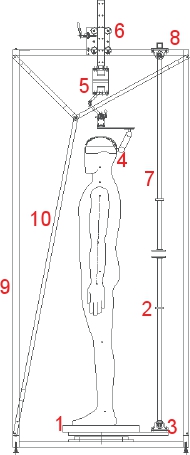
Figure 1. Schematic of Twister from the side. Components are labeled as follows: 1) rotating platform; 2) telescoping bar for lower fixation; 3) hinge joint between lower telescoping bar and rotating platform; 4) helmet attached to upper fixation; 5) torque sensor and counterbalanced suspension system; 6) locking vertical linear bearing; 7) external fixation for measuring induced torque; 8) hinge joint analogous to 3; 9) rigid frame; 10) diagonal cross bracing for rigid frame.
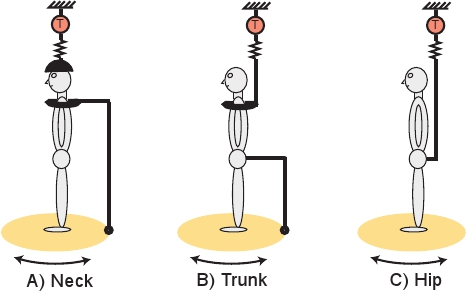
Figure 2. Twisting applied to axial and proximal levels. Subjects stand on a rotating platform (yellow) with upper and lower body attachments affixed to impart twisting to the desired body region. The upper attachment is connected via a suspension system (zigzag lines) to the torque sensor (T), which is fixed with regard to rotation around the vertical axis. The lower attachment connects to the rotating platform via a hinge joint (black circle) that allows rotation in the sagittal plane of the subject. A: Neck twisting is achieved by attaching a helmet to the torque sensor and the shoulders to the platform. B: Trunk twisting is achieved by attaching the shoulders to the torque sensor and the pelvis to the platform. C: Hip twisting is achieved by attaching the pelvis to the torque sensor.
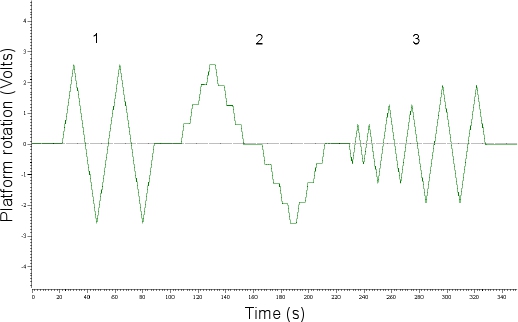
Figure 3. Different twisting profiles. Various profiles can be used to study specific aspects of tonic control. The output of the optical encoder specifying platform rotation is shown in Volts. Upward deflection corresponds to counter-clockwise platform rotation when viewed from above. 1) Triangle profile: In this case the rotational velocity, maximum excursion and number of cycles are specified. Two cycles of 12° are shown. 2) Discontinuous, step profile: Amplitude, velocity, and holding time a step are specified. Two cycles 12° rotations, consisting of four, 3° deg steps are shown. 3) Increasing amplitude triangle waves: two cycles of each of 3°, 6° and 9° rotations are shown. In this example the rate of platform rotation is constant for all conditions.
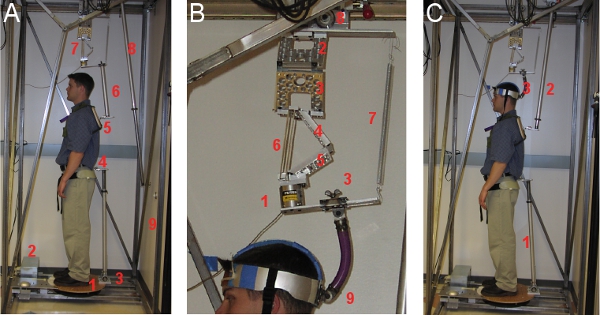
Figure 4. Photograph of Twister from the side. A: Configuration for trunk twisting with components labeled as follows: 1) rotating platform; 2) motor and servo-control assembly; 3) hinge joint between lower telescoping bar and the rotating platform; 4) lower fixation and pelvis orthotic; 5) upper fixation and shoulder harness; 6) bar connecting suspension to upper fixation; 7) torque sensor and counterbalanced suspension system; 8) external fixation for measuring induced torque; 9) rigid frame. B: Closeup of torque sensor and suspension system labeled as follows: 1) torque sensor; 2-5) lightweight hinged aluminum plates. The hinge between plates 2 and 3 rotates about the anterior-posterior axis, while the hinge between plates 4 and 5 is oriented around the mediolateral axis. 8) locking vertical linear bearing; 9) lightweight helmet and upper attachment. C: Configuration for twisting the trunk but measuring the torsional effect on the neck. In this configuration the pelvis is fixed to the rotating platform (1) and the shoulders are connected to the external fixation (2), which prevents the shoulders, neck and head from rotating, restricting twisting to the trunk. The head is also attached to the upper fixation (3) so that any induced neck torque is applied to the torque sensor.
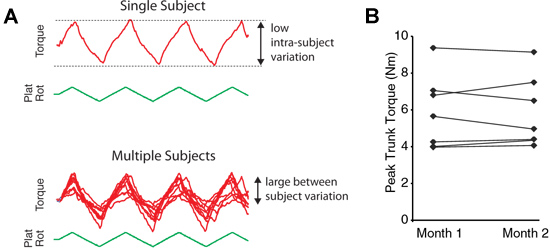
Figure 5. Torsional resistance of the trunk. A) Torque traces from individual trials from different subjects. Three cycles of 10°, 1°/s triangle waves were used. Subjects have consistent torque behavior across cycles, with large variation in resistance between subjects. Traces with highest resistance are typical of unmodulated behavior, while traces with least resistance are typical of high modulation. B) Inter-subject repeatability in torsional resistance across time. Two measurements from 7 subjects separated by one month. Peak-to-peak trunk torque shows consistent within-subject behavior across testing sessions but wide inter-subject variation.
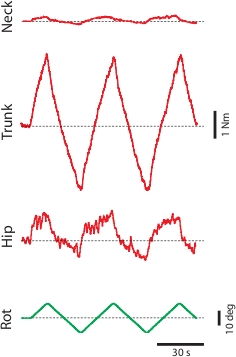
Figure 6. Restive torque from different axial levels. The resistive torque to 10°, 1°/s triangle waves for the neck, trunk and hip levels. Single trials from a representative subject are shown. Note the different magnitude and timecorse across levels.

Figure 7. Schematic of servo-control. The control loop consists of a PID (proportional, integral, derivative) controller, which receives input from an optical encoder attached to the platform shaft. The controller determines the motor drive current. Custom software running on a PC is used for selecting the desired platform trajectory, which then downloads this information to the controller.
Discussion
It is our opinion that Twister can be used address many questions in tonic control. To date, Twister has lead to 7 such publications6-11,14. Probably the most important feature of Twister is that it provides an integrated, kinetic measure of tone. This torque measure of tone is not provided by kinematic, inverse dynamics or electromyographic approaches, and is necessary to answer many questions regarding tone. Also, Twister is unique in not substantially interfering with natural antigravity or postural behavior, and provides a tonic, rather than a phasic perturbation.
One potential use of twister is the quantification of the tonic effects of disease on postural tone. While the intrinsic and reflex stiffness has been well studied for many neurological and musculoskeletal conditions using fast perturbations, the quantitative effect of many diseases on postural tone not well characterized. In particular, Twister can be used to quantify the effects of disorders such as rigidity7,10,14, hypotonia, dystonia, and back and neck pain on the magnitude, distribution and symmetry of postural tone along the body axis. It can also be used to measure axial kinesthesis, eg; perception of body rotation based on muscle proprioceptors and11 perceptuomotor symmetry, eg; representation of straight ahead during axial twisting14. Finally, Twister can be used to study the effect of intervention on these measures of axial postural tone8.
We estimate the cost of hiring an engineering firm to fabricate Twister is approximately $30,000 US. This device can likely be manufactured in-house for a fraction of this cost, as the price of raw materials is low, but significant fabrication is required. Throughout its use, Twister has evolved significantly and continues to do so. There are many basic questions that can be addressed with Twister. We hope that this report will help other investigators build Twisting devices or otherwise stimulate research into this fundamental but poorly understood area.
Açıklamalar
The authors have nothing to disclose.
Acknowledgements
We would like to thank Eugene Gurfinkel and Mark Chapman for their roles in the design and fabrication of Twister. The development of Twister was funded by National Institutes of Health grants R01 AR-31017 to P. Cordo and V. Gurfinkel and F32 HD-008520 to T. Cacciatore. T. Cacciatore would also like to acknowledge the Medical Research Council, UK for support to write this manuscript.
Referanslar
- Foster, M. A Text Book of Physiology. The Central Nervous System. Vol. III, (1892).
- Zatsiorsky, V. M. Kinetics of human motion. Human Kinetics. , (2002).
- Kumar, S. Ergonomics and biology of spinal rotation. Ergonomics. 47, 370-415 (2004).
- Kumar, S., Panjabi, M. M. Vivo axial rotations and neutral zones of the thoracolumbar spine. Journal of spinal. 8, 253-263 (1995).
- Lamoth, C. J. Pelvis-thorax coordination in the transverse plane during walking in persons with nonspecific low back. Spine. 27, E92-E99 (2002).
- Gurfinkel, V. Postural muscle tone in the body axis of healthy humans. Journal of Neurophysiology. 96, 2678-2687 (2006).
- Wright, W. G., Gurfinkel, V. S., Nutt, J., Horak, F. B., Cordo, P. J. Axial hypertonicity in Parkinson’s disease: direct measurements of trunk and hip torque. Exp. Neurol. 208, 38-46 (2007).
- Cacciatore, T. W., Gurfinkel, V. S., Horak, F. B., Cordo, P. J., Ames, K. E. Increased dynamic regulation of postural tone through Alexander Technique training. Human movement science. 30, 74-89 (2011).
- Franzen, E., Gurfinkel, V. S., Wright, W. G., Cordo, P. J., Horak, F. B. Haptic touch reduces sway by increasing axial tone. Nörobilim. 174, 216-223 (2011).
- Franzen, E. Reduced performance in balance, walking and turning tasks is associated with increased neck tone in Parkinson’s disease. Exp. Neurol. 219, 430-438 (2009).
- Wright, W. G. Axial kinesthesia is impaired in Parkinson’s disease: Effects of levodopa. Exp. Neurol. , (2010).
- Sinkjaer, T., Toft, E., Andreassen, S., Hornemann, B. Muscle stiffness in human ankle dorsiflexors: intrinsic and reflex components. J Neurophysiol. 60, 1110-1121 (1988).
- Sherrington, C. On plastic tonus and proprioceptive reflexes. Quart. J. Exper. Physiol. 2, 109-156 (1909).
- Wright, W. G., Gurfinkel, V., King, L., Horak, F. Parkinson’s disease shows perceptuomotor asymmetry unrelated to motor symptoms. Neurosci. Lett. 417, 10-15 (2007).

